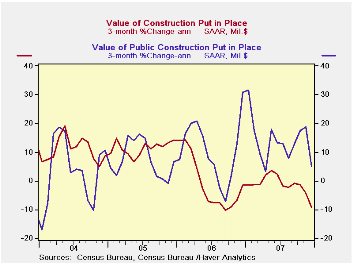 Global| Feb 04 2008
Global| Feb 04 2008U.S. Construction Spending Decline Largest Since 1991
by:Tom Moeller
|in:Economy in Brief
Summary
During December, the value of construction put in place fell 1.1% after a downwardly revised 0.4% November dip. The latest decline was the third consecutive monthly drop and it finished a year where activity fell 2.7%, the largest y/y [...]

During December, the value of construction put in place fell 1.1% after a downwardly revised 0.4% November dip. The latest decline was the third consecutive monthly drop and it finished a year where activity fell 2.7%, the largest y/y drop since 1991.
Deep recession in the housing industry weighed on residential building and dropped construction activity by 2.8% m/m after a huge 3.0% plunge during November. The annual decline of 18.3% in residential building was a record. Construction activity on new single family units was off 5.4% in December and by 27.3% for the entire year. Building activity on multi-family units also fell by a sharp 1.9% and by 6.5% for the year. Spending on improvements registered the only m/m increase in December with a 1.0% rise that limited the drop in activity to 0.3% for the year.
Housing and the "R" Word from the Federal Reserve Bank of St. Louis can be found here .
During the last twenty years there has been an 84% correlation between the q/q change in the value of residential building and its contribution to growth in real GDP.
Firm gains in nonresidential building activity continued in December to cushion the downside in overall building spending. Nonresidential building activity rose 1.3% in December for the fifth straight strong monthly gain. It raised spending by 18.2% for the year after a another double digit rise in 2006. Building in the lodging area rose a huge 62.9% during all of last year while office construction surged 20.1%. Multi-unit retail (shopping malls) rose 15.3% after gains of 28.0% and of 20.9% during the two prior years and commercial building activity surged 13.5%.
The bright spots last year in the nonresidential area also were a 20.4% gain in education and an 11.6% rise in the health care industry. Spending in the factory sector also rose by 9.2% last year after a 14.4% 2006 gain & a 26.6% 2005 surge. Spending in the transportation area increased 8.3% on the heels of a 12.2% rise during 2006.
Public construction spending also was strong last year and rose 12.5%. Construction on highways & streets rose 7.6% after increases of 11.9% and 8.8% during the two prior years. The value of construction on highways & streets is nearly one third of the value of total public construction spending. Construction spending in education area also surged by 12.8% last year after strong gains during the two prior years while spending on health care facilities jumped 28.5%.
These more detailed categories represent the Census Bureau’s reclassification of construction activity into end-use groups. Finer detail is available for many of the categories; for instance, commercial construction is shown for Automotive sales and parking facilities, drugstores, building supply stores, and both commercial warehouses and mini-storage facilities. Note that start dates vary for some seasonally adjusted line items in 2000 and 2002 and that constant-dollar data are no longer computed.
| December | November | Y/Y | 2007 | 2006 | 2005 | |
|---|---|---|---|---|---|---|
| Total | -1.1% | -0.4% | -2.3% | -2.7% | 5.6% | 10.7% |
| Private | -1.0% | -1.0% | -6.1% | -6.8% | 4.7% | 12.0% |
| Residential | -2.8% | -3.0% | -20.4% | -18.3% | 0.5% | 13.7% |
| Nonresidential | 1.3% | 1.8% | 20.4% | 18.2% | 15.2% | 7.8% |
| Public | -1.5% | 1.3% | 10.1% | 12.5% | 9.2% | 6.2% |
Tom Moeller
AuthorMore in Author Profile »Prior to joining Haver Analytics in 2000, Mr. Moeller worked as the Economist at Chancellor Capital Management from 1985 to 1999. There, he developed comprehensive economic forecasts and interpreted economic data for equity and fixed income portfolio managers. Also at Chancellor, Mr. Moeller worked as an equity analyst and was responsible for researching and rating companies in the economically sensitive automobile and housing industries for investment in Chancellor’s equity portfolio. Prior to joining Chancellor, Mr. Moeller was an Economist at Citibank from 1979 to 1984. He also analyzed pricing behavior in the metals industry for the Council on Wage and Price Stability in Washington, D.C. In 1999, Mr. Moeller received the award for most accurate forecast from the Forecasters' Club of New York. From 1990 to 1992 he was President of the New York Association for Business Economists. Mr. Moeller earned an M.B.A. in Finance from Fordham University, where he graduated in 1987. He holds a Bachelor of Arts in Economics from George Washington University.






